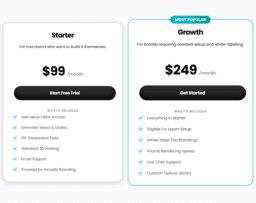Bevy vs Boundless: Which Engine is Worth the Hype?
For indie developers and enthusiasts looking for a quick, free, and data-driven game engine, Bevy is the go-to choice. However, if you’re in industries like healthcare, real estate or education desiring to leverage AR/VR for transformative experiences, then Boundless leads.

Key Differences Between Bevy and Boundless
- Coding: Bevy uses a data-oriented architecture with the ECS paradigm, while Boundless innovates with AR/VR technologies.
- Industries: Bevy caters more to game development, while Boundless has wider industrial applications like healthcare, real estate and education.
- Platforms: Bevy supports all major platforms, including Windows, MacOS, Web and iOS, while Boundless’ AR/VR technologies are utilized across various platforms.
- Toolset: Bevy has a rich set of features including 2D and 3D rendering, UI functionality, sound loading and offers easy-to-use API. Boundless exploits AR/VR for immersive and interactive experiences.
| Comparison | Bevy | Boundless |
|---|---|---|
| Focus | 2D and 3D game engine | AR/VR/XR Tech |
| Core Paradigm | Data-oriented architecture using ECS | Increasing productivity and redefining learning |
| Key Features | 2D/3D rendering, UI, sound loading, hot reloading | Immersive AR/VR experiences in multiple industries |
| Platform Support | Windows, MacOS, Linux, Web, iOS (Android expected) | Dependent on AR/VR platforms like Apple Vision Pro |
| Community Options | Discord server, subreddit, GitHub, Bevy Assets | Email, Telegram, Twitter, Website, Youtube |
| Considerations For Future Enhancements | Modern web standards like wasm and webgpu | Improved AR/VR technologies and techniques for immersive experiences |
| Future Plans | High-level/low-level networking support, Bevy-powered editor | Greater advancements, increased productivity, redefined learning |
| API Usability | Easy-to-use, despite powerful and varied functionality | Dependent on AR/VR platforms like Apple Vision Pro |
| Influence Areas | Caters to indies and enthusiasts with a long-term goal for larger studios | Architecture, Real Estate, Healthcare, Manufacturing, Engineering, Education |
What Is Bevy and Who’s It For?
Bevy is a data-driven game engine built in Rust, offering a complete 2D and 3D feature set under the Entity Component System (ECS) paradigm. With its robust functionality inclusive of 2D and 3D rendering, UI functionality, sound loading, and hot reloading, it targets indies and enthusiasts now, but seeks to enchant larger studios in the future.

Pros of Bevy
- A complete 2D and 3D feature set
- Fast compile time, reportedly between 0.8-3.0 seconds
- Rich community options
- Free, open-source, licensed under MIT or Apache 2.0 licenses
Cons of Bevy
- Dependency on Rust language advancements leading to API-breaking changes
- Lack of support for Android
- Yet to imbibe modern web standards such as wasm and webgpu
What Is Boundless and Who’s It For?
Boundless crafts the future with its focus on Augmented Reality (AR), Virtual Reality (VR), and Extended Reality (XR), transforming multitudinous industries from architecture, real estate, healthcare to education. It’s aimed at students, professionals, gamers, and educators eagerly assimilating immersive technologies in realms of learning, practice or leisure.

Pros of Boundless
- AR/VR technologies transforming numerous sectors
- Interactive and immersive learning experiences
- Advanced computer vision capabilities in AR development
- Platform for diverse applications ranging from gaming, interior design visualization to virtual try-on experiences for shopping
Cons of Boundless
- High cost of AR/VR technologies
- Limited access to technology
- Need for skilled educators to leverage AR/VR effectively
- Complexity of the technology
Bevy vs Boundless: Pricing
In stark contrast, Bevy is a free, open-source game engine, whilst no specific pricing details for Boundless are available.
Bevy
Bevy is a free, open-source game engine and is licensed under the liberal MIT or Apache 2.0 licenses, granting users high flexibility and access to a robust variety of features without incurring any cost.
Boundless
Boundless, a pioneering entity in the AR, VR, and XR technologies, does not disclose specific pricing details within the provided information.
Bevy vs Boundless – Which Reigns Supreme?
In the red corner, we have Bevy, a dynamic game engine loaded with potential, and in the blue corner, we’ve got Boundless, a master key to the AR/VR realm. Based on their unique capacities, let’s deduce who wins out for different factions in the tech industry.
FOR GAME DEVELOPERS
Bevy is your optimal ally. Its super-fast compile times, efficient Entity Component System (ECS) architecture, flexibility and lightweight binaries make game development a breeze. From hobbyists to larger studios – it caters all.
FOR AR/VR ENTHUSIASTS
If you’re vested in the immersive realm of AR/VR/XR, Boundless takes the crown. The vast applications – from real estate walkthroughs to surgical practices – limitless possibilities await. Its transformational potential across numerous industries cements it as the top pick.
FOR EDUCATORS
Boundless manifests as a compelling tool for shaping interactive learning experiences. Whether it’s anatomical explorations with AR or geographical lessons via VR, it nurtures an engaging, dynamic learning environment.
Whether it’s game creation via Bevy or an augmented learning experience through Boundless, these tools have unique ladders to climb. Yet, the verdict is clear: game devs lean towards Bevy, AR/VR enthusiasts and educators favour Boundless.







